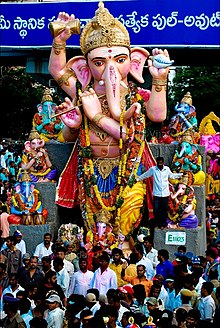Etymology and other names
Ganesha has many other titles and epithets, including Ganapati and Vighneshvara. The Hindu title of respect Shri (Sanskrit: श्री; IAST: śrī; also spelled Sri or Shree) is often added before his name. One popular way Ganesha is worshipped is by chanting a Ganesha Sahasranama, a litany of "a thousand names of Ganesha". Each name in the sahasranama conveys a different meaning and symbolises a different aspect of Ganesha. At least two different versions of the Ganesha Sahasranama exist; one version is drawn from the Ganesha Purana, a Hindu scripture venerating Ganesha.
The name Ganesha is a Sanskrit compound, joining the words gana (Sanskrit: गण; IAST: gaṇa), meaning a group, multitude, or categorical system and isha(Sanskrit: ईश; IAST: īśa), meaning lord or master.. The word gaņa when associated with Ganesha is often taken to refer to the gaņas, a troop of semi-divine beings that form part of the retinue of Shiva (IAST: Śiva).The term more generally means a category, class, community, association, or corporation. Some commentators interpret the name "Lord of the Gaņas" to mean "Lord of Hosts" or "Lord of created categories", such as the elements. Ganapati (Sanskrit: गणपति; IAST: gaṇapati), a synonym for Ganesha, is a compound composed of gaṇa, meaning "group", and pati, meaning "ruler" or "lord". The Amarakosha,an early Sanskrit lexicon, lists eight synonyms of Ganesha : Vinayaka, Vighnarāja (equivalent to Vignesha), Dvaimātura (one who has two mothers),Gaṇādhipa(equivalent to Ganapati and Ganesha), Ekadanta (one who has one tusk), Heramba, Lambodara (one who has a pot belly, or, literally, one who has a hanging belly), and Gajanana (IAST: gajānana); having the face of an elephant).
Vinayaka (Sanskrit: विनायक; IAST: vināyaka) is a common name for Ganesha that appears in the Purāṇas and in Buddhist Tantras. This name is reflected in the naming of the eight famous Ganesha temples in Maharashtra known as the Ashtavinayak (aṣṭavināyaka).The names Vighnesha (Sanskrit: विघ्नेश; IAST:vighneśa) and Vighneshvara (Sanskrit: विघ्नेश्वर; vighneśvara) (Lord of Obstacles) refers to his primary function in Hindu mythology as the master and remover of obstacles (vighna).
A prominent name for Ganesha in the Tamil language is Pille (Little Child). A. K. Narain differentiates these terms by saying that pille means a "child" while pillaiyar means a "noble child". He adds that the words pallu, pella, and pell in the Dravidian family of languages signify "tooth or tusk", also "elephant tooth or tusk". Anita Raina Thapan notes that the root word pille in the name Pillaiyar might have originally meant "the young of the elephant", because the Pali word pillakameans "a young elephant".
Street festivities in Hyderabad, Indiaduring the festival of Ganesh Chaturthi
In the Burmese language, Ganesha is known as Maha Peinne, derived from Pali Mahā Wināyaka.The widespread name of Ganesha inThailand is Phra Phikanet or Phra Phikanesuan, both of which are derived from Vara Vighnesha and Vara Vighneshvara respectively, whereas the name Kanet (from Ganesha) is rather rare.

No comments:
Post a Comment